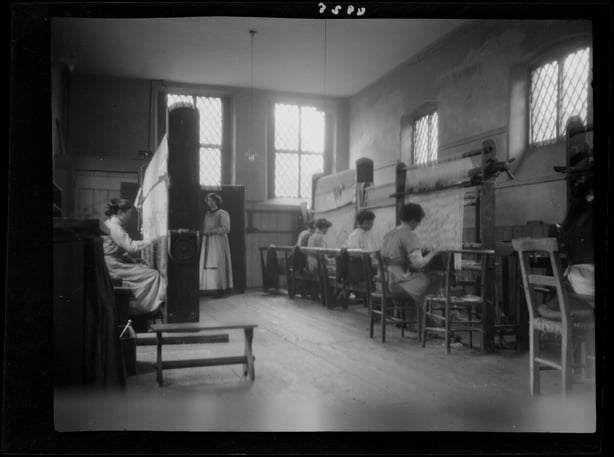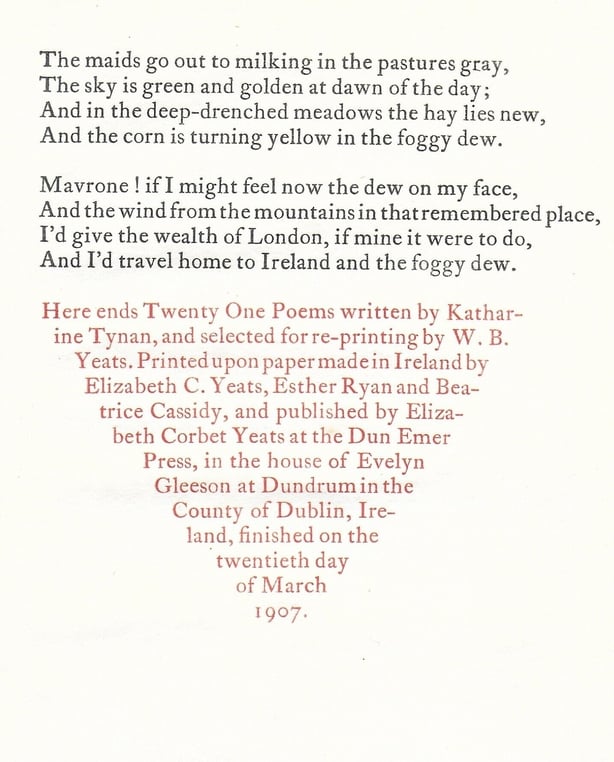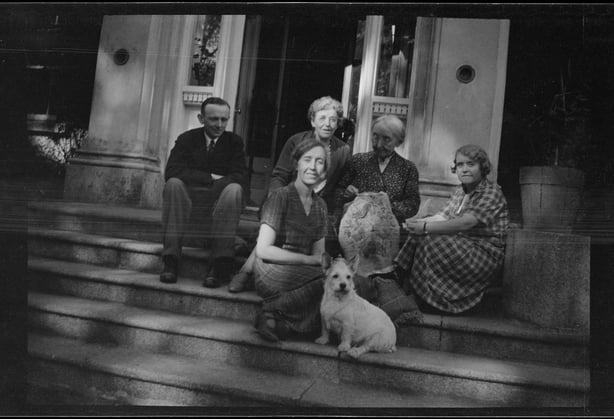Analysis: Evelyn Gleeson and the Yeats' sisters wanted their enterprise to provide women workers with economic independence and professional opportunities
Very often, the Irish Revival conjures up images of brooding poets, ancient myths and Gaelic games, rather than copyright concerns, financial accounts and marketing strategies. Yet the ideas, art and texts of the Revival had to be circulated and published at home and abroad, and a commercial and communications infrastructure underpinned and enabled this artistic, political, and intellectual renaissance.
The Dun Emer Guild was one enterprise at the beginning of the 20th century that both embodied and disseminated the work of the Revival. It had three departments: founder Evelyn Gleeson led the weaving workshop, Susan (Lily) Yeats directed the embroidery department and Elizabeth Yeats established the Dun Emer Press.

A feminist and nationalist, Gleeson sought to develop a craft guild that would educate and employ young women in Ireland. Under her guiding hand, the Dun Emer's first prospectus, printed in 1903, positioned it as a business with a political and social purpose. The women directors of the guild created a business model that would prepare employees for a not-yet-realised future: a time when women workers would have economic independence, professional opportunities and a voice in their workplace.
In that sense, Dun Emer (literally the 'Fort of Emer') was self-fashioned as a utopian female space in both prospectuses and newspaper coverage. One New York newspaper reported in October 1905 that 'it is now in fact a little republic, for not only does each have a share in the profits, but also takes part in the management, all the workers being members of the Society, with a committee in the election of which every individual member, from the eldest to the youngest has a voice.’ By 1905, some 30 women were employed at the Dun Emer workshops situated in Dundrum.
We need your consent to load this rte-player contentWe use rte-player to manage extra content that can set cookies on your device and collect data about your activity. Please review their details and accept them to load the content.Manage Preferences
From RTÉ Archives, Ronnie Drew presents a 1977 episode of Irish Men and Irish Women on Elizabeth Yeats and her work
When Elizabeth Yeats launched her private press in 1902, the Irish literary marketplace was challenging for authors, publishers and readers as the commercial publishers in Dublin could not compete with their London counterparts. Such challenges contextualise the operating model and aims of the Dun Emer Press. Yeats offered limited edition volumes to an influential subscription audience that would appreciate the Irish materials, high production values and restrained aesthetic of these books. Considerable attention was devoted to layout, typography and materials, as well as to marketing and public relations.
The Dun Emer Guild’s business strategies underpinned its survival and its transatlantic reach. For example, it hosted monthly Open Days in Dublin, welcoming potential customers and curious journalists. Newspaper coverage in Ireland, Britain and the United States reveals the successful PR aspects of this practice. Quotable content was created for the prospectus which functioned as a type of press release and was rephrased and printed in numerous reports.

The women also exhibited at international fairs across Europe and in America, developing professional networks and platforming their work for new audiences. Always struggling with financial precarity, the Dun Emer Press diversified its offerings to include more profitable side lines such as personalised bookplates, cards, broadsides and hand-coloured prints.
Significantly, the Press encouraged authors to embrace a dual-edition strategy so as to have an ‘Irish-made’ limited edition book that would advertise any ‘ordinary’ edition published elsewhere. This meant authors could publish these superior limited-edited volumes with a small press in Dublin, while retaining the possibility of printing another edition with a commercial publisher in Britain or America.
We need your consent to load this rte-player contentWe use rte-player to manage extra content that can set cookies on your device and collect data about your activity. Please review their details and accept them to load the content.Manage Preferences
From RTÉ Radio 1's Arena, report on the pioneering work of Elizabeth and Lily Yeats
The Dun Emer edition would have a material and philosophical coherence that aligned with the project of the Revival, and it would simultaneously create an aura that would transfer across to the cheaper volume. The pioneering British literary agent A.P. Watt was secured as an advisor to the press, demonstrating Yeats's recognition of the challenges of copyright across multiple distributive channels and markets.
Publishing an "Irish-made" book was critical to the identity of the Dun Emer Press. Using Irish paper and linen casing, the books were set and printed by Irish women workers. Yeats trained her apprentices in the technical aspects of printing and using the hand press. In 1907 the names of the staff members who worked on the volume (Esther Ryan and Beatrice Cassidy) appeared in the colophon for the first time. This practice of acknowledging workers’ input was distinctive and distinguished Dun Emer from other small press and avant-garde publishers.

To finance its work, the Dun Emer Press depended on subscriptions, a funding method widely used in the late 19th and early 20th century. For the cultural and business historian, such lists are illuminating as they reveal the outlines of the network that backed a given project. Certainly, the subscription list for Dun Emer’s first book, W. B. Yeats' In the Seven Woods (1903), serves as a tangible record of the impressive and influential coterie that heralded the formal launch of the press.
Luminaries of the Revival who subscribed include Lady Gregory, Oliver St. John Gogarty, T.W. Rolleston, John Quinn, Stopford Brooke, Fr. Gerald O'Donovan, James Cousins, Willie G. Fay, Helen Laird and Ella Young. Artists and craft workers include Sarah Purser, Katharine Adams, Phoebe Anne Traquair, Harold Steward Rathbone, Jack B. Yeats, Pamela Colman Smith and Harry Webb.

Other notable subscribers included the activist and salonnière Countess Plunkett, the British suffragette Evelyn Sharp, the anarcho-nationalist Nannie Dryhurst, the theosophist Alice Leighton Cleather and botanists Augustine Henry and Frederick Vernon Coville. There was also scholars such as Frederick York Powell and such British writers as Lucian Oldershaw, Thomas James Wise and Violet Dickinson.
READ: Meet Máire "Mollie" Gill, War of Independence revolutionary, Cuala Press cultural activist and All Ireland winning camogie captain
Subscribers' addresses spanned Ireland, Britain, Germany, America, Egypt, and South Africa, highlighting the transnational reach of this small Dublin business. The seriousness and deliberateness with which the press was launched is also reflected in the numerous bookdealers, bibliophiles, and publishers who subscribed. This subscription list demonstrates the complex literary ecosystem and international fanfare that underpinned and supported Dun Emer.
A business lens gives a fascinating alternative view on the Dun Emer Press. It shows how its activities and achievements were shaped by developments in the publishing industry, influential intellectual networks, and a transnational communications infrastructure. It also reveals how exploring the commercial sections of literary archives can illuminate the business acumen and strategic planning of key figures of the Irish Revival.
The author will discuss the Dun Emer Press as part of a session on Pioneering Women Writers and Publishers at the Roger Casement Summer School at the Lexicon Library, Dún Laoghaire, Co Dublin on Saturday May 6th. Tickets are available here
The views expressed here are those of the author and do not represent or reflect the views of RTÉ



